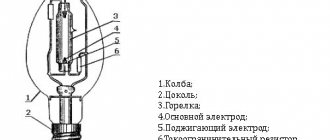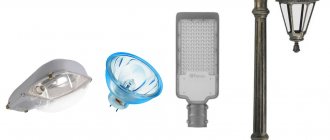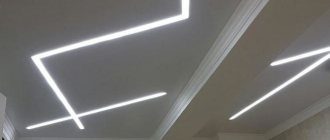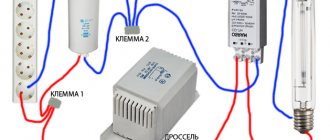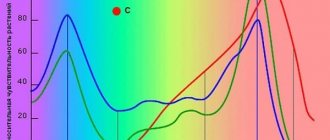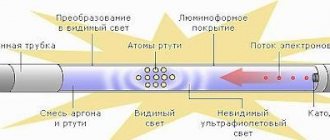Before considering the technical characteristics of a 250 W HPS lamp, you should understand what this light source is, what its design and principle of operation are. Lighting experts are familiar with the product, but for beginners the term “high pressure sodium arc tube lamp” means nothing. In addition, the lamp is made in the form of a tube, and the emitting element is sodium.
DNaT are time-tested, reliable lighting devices, not without disadvantages compared to modern analogues.
Two decades ago, such lamps were used to illuminate highways around the world, but over time they began to be replaced by LED devices. By the way, sodium lamps have not become a thing of the past: experienced designers often include them in their projects, and this is due to a number of reasons. Firstly, the cost of LEDs is much higher, secondly, the energy efficiency of the latter is not so high, and thirdly, the number of manufacturers of LED products is too large, which is why it is sometimes difficult to choose high-quality devices.
DNAT in simple words
HPS lamps abroad are called HPS Lamp, which stands for High-Pressure Sodium Lamp, translated as “high-pressure sodium lamps” and abbreviated in Russian as NLVD. The first NLVDs were produced in the Soviet Union in the form of an ellipse or tube, with a transparent or matte bulb, with or without mirror coating, and of varying power.
It turns out that HPS is a type of NLVD light source, but when choosing a German product from Osram, be prepared to see a name like VIALOX NAV-T 250 W SUPER 4Y.
NLVD also includes other light sources - DNaZ (mirror coating) and DNaS (light-scattering bulb).
Design
When considering the design of a HPS lamp, we see the following elements:
- glass flask;
- cylindrical tube with aluminum holder.
The cavity of the tube is filled with mercury vapor (as in luminescent sources) and sodium vapor, forming a sodium amalgam. But these are not all gaseous substances: xenon is used to start the product.
HPS comes in both high and low pressure. This parameter is essentially related to the color temperature: in the first case, the lamp has a light yellow tint, in the second - muted yellow (like halogen and incandescent lamps).
Xenon is located inside the burner, which ensures a smooth start-up of the equipment. To increase service life, two burners can be used simultaneously.
Burner
The same cylindrical tube mentioned above. Made from transparent ceramics, resistant to high temperatures and chemically active substances. It was first manufactured by General Electric in 1960 and patented under the name “lucalos” (we know it as “polycor”). Its creation is based on the technology of sintering aluminum oxide at high temperatures. Tungsten electrodes are soldered to the two ends of the tube.
Inside it there is a mixture of inert gases and sodium amalgam under a pressure of 100 kPa and above, which makes it easy for an electrical discharge to occur due to the higher density of the medium, and also expands the region of the visible spectrum.
Base
To connect to the power lines, an Edison type E threaded socket is used. For HPS lamps with a power of 50, 70 and 100 watts, size E27 is used, for more energy-intensive models of 150, 250 and 400 watts - E40. The number indicates the diameter of the cartridge in millimeters.
The device of sodium lamps
Externally, these lamps are similar to DRL. The outer body is a cylindrical cylinder made of glass, but it can also be in the shape of an ellipse. It contains a “burner” - a tube inside which an arc discharge occurs. The electrodes are located at its ends. They are connected to the base. Sodium is not used in the manufacture of the “burner”, since its vapors have a rather strong effect on the glass body. In addition, the outer flask also plays the role of a “thermos” - it isolates the burner from the external environment.
The figure mentions a getter. It is rarely mentioned in reference documentation. A getter is a gas absorber, an adsorber. It is capable of capturing and retaining gas with the exception of inert ones. It finds its application not only in gas-discharge lamps, but also in radio electronics - electric vacuum devices. Its main purpose is to increase service life. The absence of foreign substances reduces “poisoning” of the electrodes.
The burner itself is made of polycor - polycrystalline aluminum oxide. It is obtained by sintering. Moreover, only the alpha form of the crystal lattice is acceptable for the manufacture of the discharge tube body. It is characterized by the maximum density of “atomic packing”. This is a development by General Electric. The developer called this material “lucalos”. It is resistant to sodium vapor and transmits about 90 percent of visible radiation. For example, dnat 400 has a tube 8 centimeters long and 7.5 millimeters in diameter. With increasing power, the size of the “burner” increases. The electrodes are made of molybdenum. In addition to sodium in vapor form, an inert gas, argon, was pumped in. It is required to facilitate discharge formation. To improve light output, mercury and xenon are introduced. When the lamp is operating, the temperature in the burner reaches 1200-1300 Kelvin. About 13,000 Celsius. To prevent damage, air is pumped out of the flask. The vacuum is quite difficult to maintain, since thermal expansion can cause microscopic cracks and holes to appear. Air can enter through them. To eliminate this, special gaskets are used. The flask does not heat up as hot as the burner. The usual temperature is 1000 C. The glow shows orange, yellow, and golden colors.
Previously, lamps had only a round threaded base, like household incandescent lamps. However, recently a new type of base has appeared - Double Ended.
Regardless of the design, the spectrum will be approximately the same.
This type of lamp is mainly used by agricultural enterprises. They are usually twice as thin as a standard sodium lamp. The flask is made of quartz. There is nitrogen inside the flask. The burner has two electrodes for supplying a pulse and subsequent supply voltage to maintain the discharge. The leads are located at the ends of the lamp; this is a more advanced solution that avoids thermal deformation of the bulb.
HPS lamps with two burners have also been developed.
The variety shown in the photo is usually used for greenhouse placement (for supplementary lighting purposes). The second burner is a metal halide lamp. In fact, this model is a hybrid of DNAT and MGL in a single package.
But there are also models that contain a pair of identical burners. They are located in a common cylinder and connected in parallel. This is done to alternately use each of the gas-discharge tubes. During operation, only one emits light. The one that lights up is the one where the conditions are more suitable. This solution reduces overall operating costs. Otherwise, the options with one or two tubes do not have any fundamental differences; the power and luminous flux parameters will be the same. The schematic diagrams do not change.
Operating principle
For an electric charge to occur in a gaseous medium, a high voltage pulse is required. Since sodium melts at a fairly high temperature, the electric charge ignites slowly: low-power HPS produces a full luminous flux after 5-6 minutes, and high power - after 10-15 minutes.
At the moment of startup, the environment is cold, its electrical resistance is low, so the process is accompanied by an avalanche-like increase in current in the circuit, which can cause overheating and destruction of the lamp electrodes. Therefore, the DNAT control gear includes an electronic ballast (choke) - an inductor without a core. Compensation occurs due to the emergence of a magnetic flux directed opposite to the current that generated it.
Why do you need a capacitor?
In addition, it is recommended to use a capacitor in the connection kit. Although it is not present in all schemes.
Why is it needed? As is known, circuits using power chokes consume both active and reactive power. From the second, you will not get any beneficial effect.
This will not make the lamp shine brighter, but the losses will increase. It is in order to remove this reactive component that a phase-compensating capacitor is used.
For lamps of different power, you need to select the appropriate capacity. Here are the recommended capacitor capacitance parameters, depending on the power of the chokes:
A visual comparison of the current consumption of a HPS lamp with and without a capacitor:
As you can see, more than double the difference. In the first case, the compensated current (active) is shown, and in the second case, the full current (without a capacitor in the circuit).
Some people think that by doing so they also reduce energy consumption, but this is not entirely true.
Your meter is not designed to count reactive or apparent energy, and the actual cost savings can be a maximum of 3-4%.
But you will eliminate unnecessary losses due to heating of wires and iron.
Comparison of technical characteristics
The table below presents a comparison of the technical characteristics of a high-pressure mercury gas discharge lamp (HPD) and a tubular sodium arc lamp (HSA) of the same power - 250 W.
| DRL-250 | DNAT-250 | |
| Power, W) | 250 | 250 |
| Specific luminous flux (Lm/W) | 45 | 90 |
| Total Luminous Flux (Lm) | 13500 | 28000 |
| Continuous operation time (hour) | 12000 | 20000 |
| Base type | E40 | E40 |
| Color temperature (K) | 3800 | 2000 |
| Color rendering index (Ra) | 45 | 25 |
| Full warm-up time (min) | 5–10, depending on ambient temperature | |
| Length (mm) | 228 | 250 |
| Bulb diameter (mm) | 91 | 48 |
Luminous flux and technical characteristics of a 250 W lamp
Most often, 250W HPS is installed in outdoor lamps since the lamps emit a powerful luminous flux. Thanks to its bright light, the device improves visibility even in the presence of airborne particles.
When choosing a lighting element, you need to study its parameters. This will help you choose the right lighting device and determine the scope of the light source.
Characteristics of DNAT 250:
- Rated power – 250W.
- The voltage on the light bulb is 220W.
- Luminous flux – 26000 Lm.
- Light output – 108 LM/W.
- Color temperature – 2000K.
- Color rendering coefficient – 25Ra.
- Type of detachable connector – E40.
- Lamp diameter – 48 mm.
- Lamp length – 235 mm.
- Operating life – 15,000 hours.
Advantages and disadvantages of DNAT
The advantages of this type of lamp are visible from the table above. First of all, it has greater energy efficiency. The working resource is also significantly higher. Due to its compactness, it can be installed in smaller luminaires. The color temperature matches natural sunlight. At this spectral frequency, the luminous flux is not affected by snow flakes, raindrops, fog or dust.
It also has its drawbacks. The time it takes to reach full luminous flux is very long - in severe frost, DNAT 250 can flare up to full power only after 15 minutes (the time depends on the power of the light source) . Due to the low color rendering index, interior items may have a completely different appearance when illuminated. During operation, flickering appears from an industrial network with a frequency of 50 Hz, which has a negative effect on the visual apparatus. You won't be able to work for long in this light.
Connecting a HPS lamp from the DRL choke
Many people wonder whether it is possible to connect such a light bulb from a choke of the same power, designed for a DRL lamp? Theoretically, this is possible, the main thing is to exclude the IZU from the circuit.
However, although the powers may be the same, due to different operating voltages on the lamps, the HPS and DRL ballast will produce different operating output currents.
1 of 2
And this will directly reduce the service life of the lamp (if the current is exceeded), or, on the contrary, will not allow it to reach the calculated luminous flux (at lower current).
There are sodium lamps with built-in ignitors. Some people mistakenly consider them universal and use them directly as a replacement, for example, in lamps with 250W DRL.
On the one hand, it’s a complete benefit. It turns out that with a lower power of 220W instead of 250W, you can easily get a much larger luminous flux.
- DRL luminous flux 250W – 13000Lm
- luminous flux such as DNAT 220W – 18000Lm
No circuit modifications, just change the bulbs and get several thousand lumens more light. However, such models must also be used with ballasts designed specifically for sodium lamps.
Otherwise, this will affect the service life of the lamp.
Areas of application
First of all, sodium lamps are used for street lighting, on lampposts on highways and other objects where suspended particles in the air can adversely affect safety. The light of sodium arc lamps is able to break through thick fog, rain and snow, which cannot be said about energy-efficient LED lamps.
Due to the high content of ultraviolet and infrared waves, the equipment is used in greenhouses. It has a beneficial effect on the development and fruiting of the plant, warming the air and accelerating photosynthesis.
It is strictly prohibited to use HPS at work sites where accurate color recognition is required.
Installation and connection features
Despite the fact that sodium lamps have a wide range of applications, they are mainly used in the organization of street lighting. This is due to insufficient transmission of the color spectrum. In this case, there is no particular difference in what position the lamps will be located. At the same time, as long-term practice shows, their most effective position is horizontal. In this case, the main light flux is emitted in different directions.
To properly connect the lamps, as we now know, you cannot do without the help of third-party “equipment”. We are talking about ballast, or in other words, a choke for HPS, as well as a pulse triggering device (IZU). Without this, the sodium lamp will simply refuse to start. They have already been mentioned, but now it’s time to get to know them better.
Connection diagrams
To connect the HPS to the network, ballast equipment is used, consisting of a ballast choke and a high-voltage pulse source (HVPS). The first element is connected in series, and the second - in parallel with the lamp. The current passing through the inductor and the IZU starts the lamp.
The power of the choke must correspond to the power of the light source. And it is connected precisely to the phase line, which can be determined using a simple indicator screwdriver. To compensate for the reactive component of the current and reduce energy consumption, a quenching capacitor is connected in parallel with the lamp. For DNAT-250, you can use a model with a capacity of 35 μF. This is an optional schema element.
There is no consensus among electrical engineers regarding the use of IZU. The fact is that there are two types:
- with two connection points;
- with three connection points.
Two-point IZU
The self-oscillation generator circuit is built on two dinistors. It is switched on in parallel with the lamp, so the device does not have a balancing effect on the electrical circuit when the starting current increases. Because of this, the throttle may be broken. After starting the lamp, the IZU continues to operate, increasing energy consumption.
Three-point IZU
A special feature of the device is that the phase line passes through it and through this circuit it is connected in series with the lamp. Therefore, when starting, its throttle has an additional compensating effect and better stabilizes the system. The circuit is based on the latest generation of semiconductors that have the best performance characteristics. For these reasons, it is preferable to use it.
What if the lamp doesn't work?
As sodium lamps age, they acquire the nasty habit of "blinking" i.e. the lamp turns on, warms up as usual, then suddenly goes out and a minute later everything repeats. If you notice this behavior, try changing the lamp. If changing the lamp does not help, gently measure the voltage in the network, it may be lower than usual... If the blinking occurs irregularly, a bad contact or voltage surges in the network may be to blame.
It happens that after turning on the lamp you can hear the IZU crackling (i.e. there is voltage), but the lamp does not even try to light up. Most often this happens due to a breakdown in the wire running from the IZU to the lamp or indicates a completely burnt-out lamp; less often, a broken wire between the ballast and the lamp or a burnt IZU is to blame.
Try changing the wire between the IZU and the lamp
Pay attention to the condition of the IZU contacts. If it doesn't help, try changing the lamp. If it doesn’t help, turn off the IZU (otherwise it can burn the voltmeter with its impulses!) and measure the voltage on the lamp socket - for the DNAT it should correspond to the network voltage
If there is voltage on the cartridge, change the IZU
If it doesn’t help, turn off the IZU (otherwise it can burn the voltmeter with its impulses!) and measure the voltage on the lamp socket - for the DNAT it should correspond to the mains voltage. If there is voltage on the cartridge, change the IZU.
If the lamp does not show any signs of life at all: the IZU does not buzz, the lamp does not glow - most likely either the fuse has blown out or the contact in the power cord has been broken. Perhaps the culprit is a burnt IZU or a break in the winding in the ballast - check the ballast as described below, if it is intact, change the IZU.
The ballast is checked with a regular Ohm meter. Normally their resistance is about 1–2 ohms. If the resistance is significantly greater, it means either a break in the winding or contact between the winding terminals and the connecting block is broken (try tightening the screws). With an interturn closure, everything is more complicated - it has very little effect on the DC resistance, making it difficult to detect, while the power supplied to the lamp is much greater than necessary. When the lamp exceeds its power, it quickly overheats and goes out, resulting in the same “blinking” behavior.
Precautions for use
The outer bulb of the lamp heats up to a temperature of 250–300 degrees. Celsius. This determines the list of safety measures when working with it.
- Do not touch the lamp bulb for 10–15 minutes after turning it off.
- You should absolutely not touch the flask with your hands without gloves: traces of sweat and grease on the surface will lead to uneven heating and even an explosion.
- Provide good ventilation for the lamp and keep it away from flammable structures. The same applies to the ballast choke, which heats up to 150 degrees. Celsius.
In addition, protect the lamp from impacts: when the bulb explodes, fragments fly over a very long distance. If the burner is damaged, the room or area may be contaminated with mercury.
Disposal conditions
The burners of high-pressure sodium lamps contain sodium amalgam, an alloy of sodium and mercury. It is strictly forbidden to throw HPS into containers with regular household waste or bury it in the nearest vacant lot. Disposal of devices is carried out according to the same rules that are adopted for DRL lamps and other devices containing mercury.
High pressure sodium arc lamps have very good technical characteristics. In terms of energy efficiency and service life, they compete with LED light sources, so people will continue to use them in various spheres of life for a long time.


